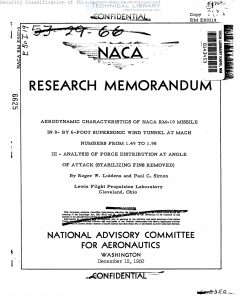naca-rm-e50i19
- Version
- 39 Downloads
- 1.35 MB File Size
- 1 File Count
- April 24, 2017 Create Date
- April 24, 2017 Last Updated
National Advisory Committee for Aeronautics, Research Memorandum - Aerodynamic Characteristics of NACA RM-10 Missile in 8x6 Foot Supersonic Wind Tunnel at Mach Numbers from 1.49 to 1.98 - III - Analysis for Force Distribution at Angle of Attack (Stabilizing Fins Removed)

An analysis of the force distribution on a slender pointed
body of revolution at angle of attack was made utilizing pressure-
distribution data and balance measurements. The data were obtained
in.the NAGA Lewis 8- by 6-foot supersonic tunnel at Mach numbers of
1.49, 1.59, 1.78, and 1.98 and for a range of angles of attack from
0° to 9°. The Reynolds number based on the model length was approxi-
mately 50,000,000. The parabolic body inrestigated was the half-
scale model of the NAGA supersonic flight-research’missile designated
RM-lo (with stabilizing fins removed). A second model consisting of
a cone-cylinder combination was investigated to isolate the effect of
profile curvature.
The inability to predict the normal force distribution due to
angle of attack on slender bodies of revolution by the existing
linearized potential theory was due in part to inaccurate prediction
by the theory of the pressure distribution due to angle of attack on
bodies with curved profiles, and in part to neglecting the effects
of cross-flow separation.by the theory. A concept of the linearized
potential theory (in which the radius of the body is assumed to
approach zero) is presented, which approximately eliminates the
shortcomings of the theory with regard to the curved profiles.
The axial friction and fore pressure force remained essentially
constant with angle of attack. The increase in total axial force
with angle of attack was primarily due to an increase in base pres-
sure force.
Many methods are available for predicting the aerodynamic
forces acting on slender bodies of revolution (at angle of attack)
moving at supersonic speeds. Two representative methods for pre- _
dieting the normal forces on slender bodies of revolution inclined
to a supersonic stream are linearized potential- theory, which seri-
ously underestimates the measured values and the method of ref-
erence 1, which greatly improves the estimation by modifying the
potential theory in an attempt to account for viscous effects. The
assumption of constant separation made in reference 1, however, is
inconsistent with the pressure distributions observed on the RM-lO
model (reference 2).
| File | Action |
|---|---|
| naca-rm-e50i19 Aerodynamic Characteristics of NACA RM-10 Missile in 8x6 Foot Supersonic Wind Tunnel at Mach Numbers from 1.49 to 1.98 - III - Analysis for Force Distribution at Angle of Attack (Stabilizing Fins Removed).pdf | Download |

Comment On This Post